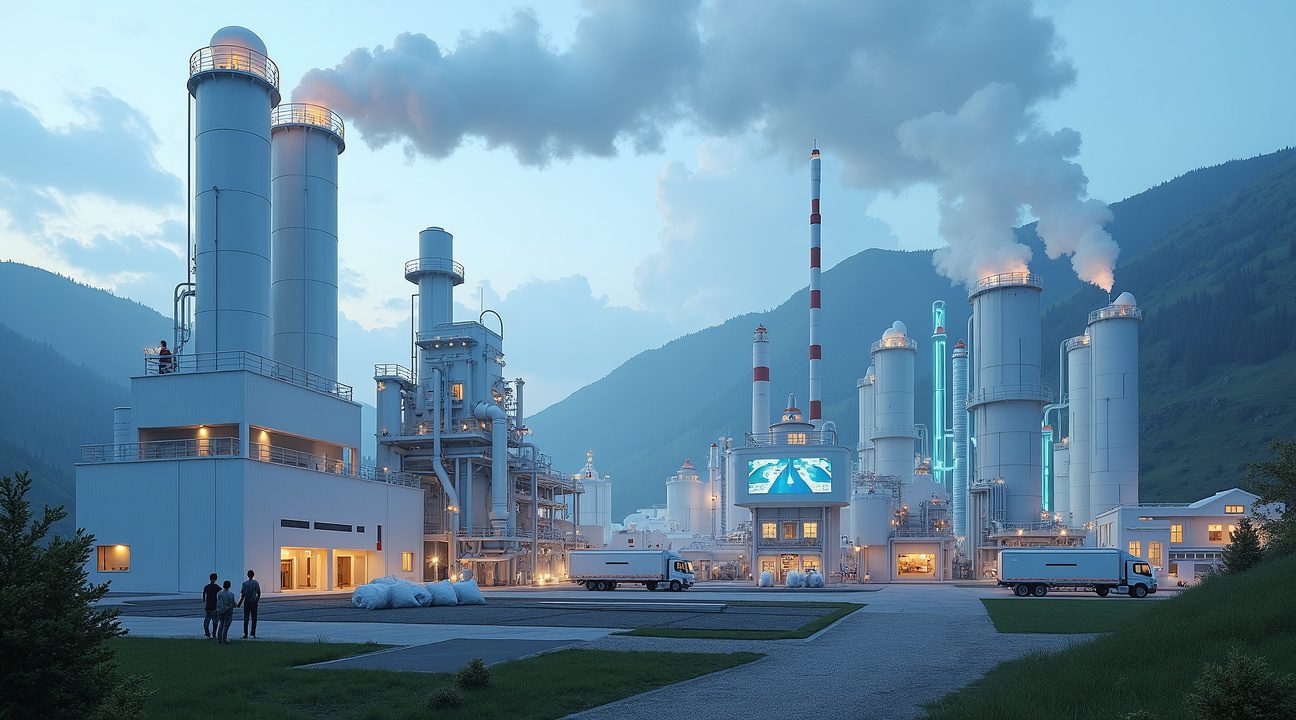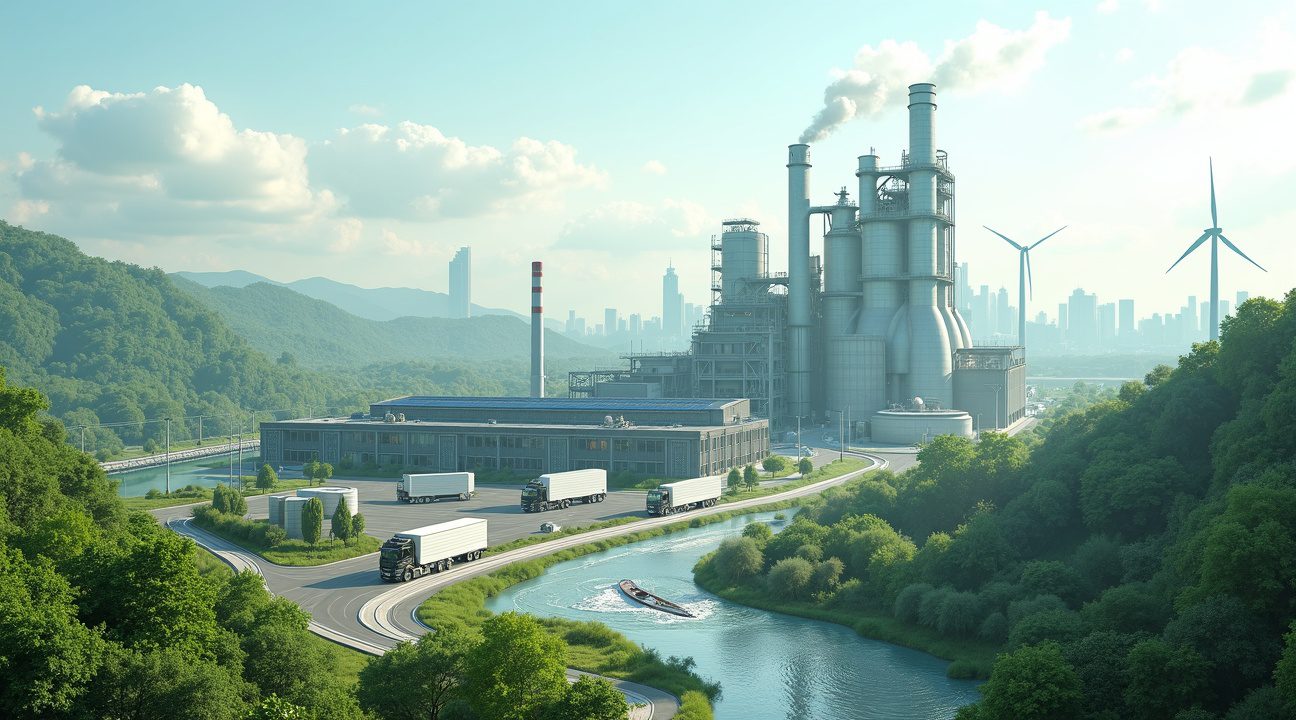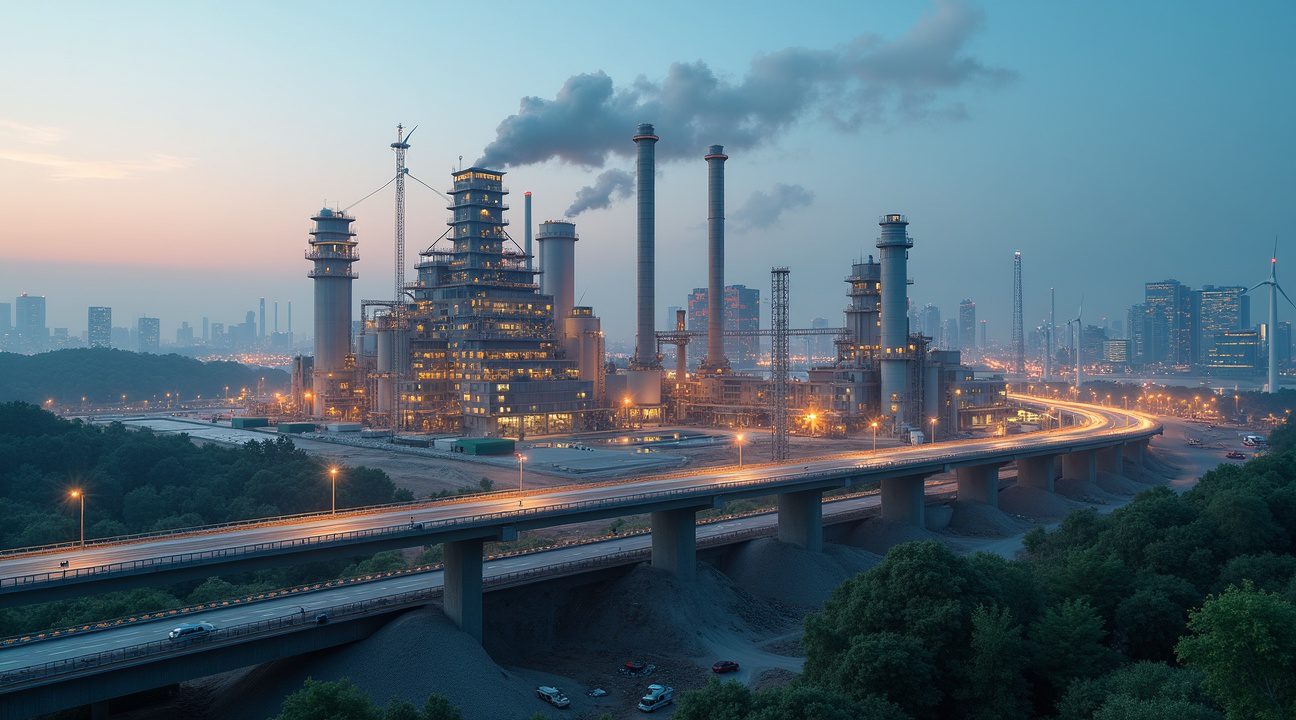The U.S. cement industry is undergoing a significant transformation as companies increasingly invest in electric cement production technologies and carbon capture systems to meet growing environmental regulations and secure government contracts.
Industry Innovations and Strategies
Major manufacturers such as Holcim US, Heidelberg Materials, and CEMEX USA are pioneering innovations that are reshaping the cement production landscape. These new technologies include electric kilns, carbon capture utilization and storage (CCUS) systems, and cutting-edge digital traceability platforms that are redefining how cement is produced and delivered in the United States.
Key Takeaways
- Electric cement technology is becoming a competitive advantage – Companies that adopt electric kilns and CCUS systems are gaining preferential treatment in federal and state-level infrastructure bidding. These agencies are increasingly prioritizing low-carbon alternatives for public construction projects.
- Market growth remains strong despite short-term challenges – The U.S. cement market is forecasted to reach $17.95 billion by 2029 with a steady compound annual growth rate of 4.2%. This is fueled largely by the $1.2 trillion Infrastructure Investment and Jobs Act and an anticipated surge in cement demand from AI data centers, expected to require approximately 1 million metric tons by 2028.
- Production costs and import dependency are rising sharply – Domestic production dropped by 4% in 2024, totaling 84 million tons. Simultaneously, prices increased from $139 to $160 per ton, leading to a greater reliance on 24 million tons of imported cement and nearly 1 million tons of imported clinker.
- Environmental compliance drives business strategy – Regulations like Buy Clean rules and evolving ESG requirements are reshaping procurement standards. This includes mandates for real-time emissions monitoring, blockchain-based tracking technologies, and third-party verification systems as prerequisites for securing government construction contracts.
- Carbon capture pilots demonstrate commercial viability – Industry leaders are piloting carbon capture projects aimed at reducing emissions. For example, Heidelberg Materials is targeting a 95% emissions capture rate at its Indiana facility, setting the stage for significantly reduced carbon outputs while preserving production efficiency.
U.S. Cement Market Set to Hit $17.95 Billion by 2029 Despite Near-Term Challenges
The U.S. cement market demonstrates remarkable resilience despite facing immediate headwinds. Projections indicate the market will reach $15.22 billion in 2025, maintaining a steady annual growth rate of 4.5%. This momentum continues through the decade, with a cumulative CAGR of 4.2% expected for 2025-2029, ultimately pushing the market value to $17.95 billion by 2029.
Infrastructure Investment Drives Long-Term Growth
The $1.2 trillion Infrastructure Investment and Jobs Act (IIJA) serves as a primary catalyst for cement demand growth. This massive federal investment focuses on highway modernization, bridge reconstruction, and port development projects across the nation. Such large-scale infrastructure initiatives create sustained demand for cement products, providing industry stability even during uncertain economic periods.
Data center construction emerges as an unexpected but significant growth driver. The rapid expansion of artificial intelligence capabilities requires substantial infrastructure investment, with projections showing AI data centers alone will need approximately 1 million metric tons of cement by 2028. This demand reflects the ongoing digital transformation and the critical need for robust data infrastructure to support emerging technologies. I’ve noticed how tech innovations continue reshaping various industries, including construction materials.
Navigating Short-Term Market Volatility
Current market conditions present notable challenges for cement manufacturers and suppliers. Cement consumption declined by 5.2% in 2024, with another 1.6% decrease anticipated for 2025. High interest rates significantly impact construction activity, particularly in residential markets where financing costs directly affect building decisions. The cooling housing market compounds these pressures, creating temporary demand reduction across multiple cement applications.
Several regional and sectoral trends offer optimism despite overall market contraction:
- Sun Belt states continue experiencing robust residential construction activity due to population migration and favorable business climates.
- Industrial facility construction maintains strong momentum, particularly for EV battery manufacturing plants and semiconductor facilities.
- Specialized projects often require large cement volumes and operate on accelerated timelines.
Regional demand patterns vary considerably across the United States. States like Texas, Florida, and Arizona show consistent cement consumption growth due to continued population influx and business relocations. Meanwhile, traditional manufacturing regions adapt to new industrial requirements, with many areas seeing increased demand for specialized cement products suitable for high-tech manufacturing facilities.
The cement industry’s adaptation to electric alternatives represents a significant development trend. Electric cement production methods promise reduced carbon emissions and improved sustainability metrics. Early adoption of these technologies positions manufacturers advantageously for future regulatory requirements and environmental standards. Innovation in cement production aligns with broader infrastructure modernization goals supported by federal investment programs.
Market analysts expect volatility to moderate as interest rates stabilize and economic conditions improve. The combination of federal infrastructure spending, technological advancement requirements, and regional growth patterns creates a foundation for sustained cement demand growth. Electric cement development particularly benefits from this environment, as sustainability considerations become increasingly important in public and private construction projects.
Looking ahead, the cement market’s trajectory appears positive despite near-term challenges. Federal infrastructure commitments provide demand certainty, while emerging sectors like data centers and clean technology manufacturing create new growth opportunities. The industry’s evolution toward electric production methods positions it well for future environmental regulations and market preferences, suggesting continued expansion beyond the current forecast period.
Major Cement Companies Launch Carbon Capture Projects and Electric Cement Innovations
The U.S. cement industry is experiencing a fundamental transformation as companies race to meet increasingly strict carbon regulations. I observe major players implementing groundbreaking technologies that promise to reshape how cement gets produced and consumed across the nation.
Leading Carbon Capture Initiatives Gain Momentum
Holcim US has partnered with Svante to develop a revolutionary carbon capture pilot project in Colorado, supported by substantial DOE grants. This collaboration represents one of the most ambitious attempts to prove carbon capture technology can work at commercial scale in cement production. Meanwhile, Heidelberg Materials has set an even more aggressive target at their Mitchell, Indiana plant, aiming to capture an impressive 95% of emissions.
These carbon capture, utilization, and storage (CCUS) pilots demonstrate the industry’s commitment to dramatic emissions reductions. Companies are investing heavily in these technologies because traditional cement production accounts for approximately 8% of global CO2 emissions. The success of these projects could establish a new standard for the entire industry.
Electric and Blended Cement Solutions Transform Market Dynamics
Electric cement innovations are gaining traction alongside alternative formulations that reduce carbon intensity. Companies like CEMEX USA and Argos USA are scaling up blended cements that incorporate limestone, pozzolans, and slag to meet LEED certification requirements and state DOT compliance standards.
These developments align perfectly with green procurement initiatives. Buy Clean California and New York’s Low Embodied Carbon Concrete Leadership Act are driving demand for these innovative products, creating market incentives for continued development. State agencies now prioritize low-carbon alternatives when awarding contracts, fundamentally shifting purchasing patterns.
Circular material usage is expanding rapidly across the sector. Ash Grove Cement, now part of CRH, has implemented co-processing systems for waste fuels, while the industry increasingly embraces recycled aggregates and fly ash. This shift reduces dependence on virgin raw materials while creating new revenue streams from waste products.
The integration of tech innovations in cement production mirrors broader industry trends. Electric heating systems and alternative fuel sources are becoming standard considerations for new plant designs. Companies recognize that early adoption of these technologies will provide competitive advantages as regulations tighten further.
These initiatives represent more than environmental compliance; they’re strategic investments in the industry’s future. The companies successfully implementing these technologies today will likely dominate tomorrow’s low-carbon cement market.

Production Drops 4% While Import Dependency and Costs Rise Sharply
The U.S. cement industry faces mounting pressures as domestic production continues to decline while costs surge across multiple fronts. Production figures for 2024 paint a concerning picture, with total cement output falling 4% to an estimated 84 million tons. This decline extends beyond standard cement, affecting both clinker and masonry cement production as manufacturers grapple with operational challenges that have persisted throughout the year.
Import Reliance Reaches Critical Levels
America’s dependence on foreign cement has reached alarming proportions, with imports accounting for a substantial portion of total consumption. The country imported 24 million tons of hydraulic cement and nearly 1 million tons of clinker in 2024, highlighting the growing gap between domestic production capacity and market demand. This heavy reliance on imports creates vulnerabilities in supply chains and exposes the industry to international price fluctuations and geopolitical risks.
The substantial import volumes underscore the strategic importance of developing innovative technologies like electric cement solutions that could potentially revitalize domestic manufacturing. Current production constraints limit the industry’s ability to meet growing infrastructure demands, forcing contractors and developers to rely increasingly on foreign suppliers.
Cost Pressures Drive Price Increases
Multiple factors have converged to create a perfect storm of rising costs throughout the cement manufacturing sector.
Key cost drivers include:
- Energy expenses: Cement production requires intensive heat processes that consume substantial amounts of fuel and electricity. Elevated energy costs directly impact production economics.
- Permitting delays: Lengthy approval processes extend project timelines and delay modernization efforts, increasing regulatory compliance costs.
- Logistics constraints: Transportation difficulties affect raw material procurement and product distribution, adding unexpected costs and inefficiencies.
The cumulative impact of these pressures becomes evident in pricing data, with the average mill unit value jumping dramatically from $139 per ton in 2023 to $160 per ton in 2024. This 15% price increase reflects the industry’s struggle to maintain profitability while managing escalating operational costs. Construction companies and infrastructure developers now face significantly higher material costs, which could impact project feasibility and completion timelines.
Despite these production and cost challenges, employment levels in cement mining and milling operations have remained remarkably stable. Approximately 12,300 workers continue to find employment in these sectors, suggesting that companies are maintaining their workforce even as they reduce output volumes. This stability in employment numbers indicates that manufacturers are optimizing operations rather than implementing widespread layoffs, potentially positioning themselves for future recovery when market conditions improve.
The employment data also suggests that companies recognize the value of maintaining skilled workers who understand complex manufacturing processes. Retaining experienced personnel becomes particularly important as the industry explores advanced manufacturing techniques and considers implementing new technologies that could transform production methods.
Current market dynamics highlight the urgent need for innovation in cement manufacturing. Traditional production methods face increasing pressure from environmental regulations, energy costs, and supply chain vulnerabilities. The industry’s reliance on imports creates opportunities for domestic manufacturers who can develop more efficient, cost-effective production technologies that reduce energy consumption and environmental impact.
Production challenges also emphasize the importance of strategic planning for infrastructure development. Government agencies and private developers must account for higher cement costs and potential supply constraints when planning major construction projects. These market conditions could accelerate interest in alternative construction materials or innovative cement formulations that offer cost advantages over traditional products.
Federal Buy Clean Rules and ESG Requirements Drive Industry Transformation
Government procurement policies are reshaping the cement industry landscape as federal and state-level ‘Buy Clean’ rules increasingly prioritize low-carbon and Environmental Product Declaration (EPD)-certified cement for public infrastructure projects. These regulations require contractors to demonstrate reduced carbon footprints and transparent environmental reporting when bidding for government contracts, creating a direct market incentive for sustainable cement production.
Major cement manufacturers are responding by investing heavily in emissions data transparency systems and digital traceability platforms. Companies now track their products from raw material extraction through final delivery, providing detailed carbon footprint documentation that meets stringent government requirements. This shift requires sophisticated data collection systems and third-party verification processes that were previously unnecessary in the traditional cement market.
Supply chain resilience has become equally critical as firms adapt to these new procurement standards. Companies are diversifying their supplier networks and implementing backup systems to ensure continuous compliance with environmental standards. The financial implications are significant – securing government contracts often represents millions of dollars in revenue, making ESG compliance a business necessity rather than a voluntary initiative.
Key Changes in Industry Practices
The transformation extends beyond simple compliance measures to fundamental business strategy shifts:
- Implementation of real-time emissions monitoring systems that track carbon output during production
- Development of blockchain-based tracking systems for cement batches to ensure supply chain transparency
- Creation of dedicated sustainability teams focused specifically on meeting government procurement requirements
- Investment in alternative fuel sources and energy-efficient production methods to reduce overall carbon intensity
- Establishment of partnerships with third-party verification companies to validate environmental claims
Green mandates are accelerating innovation timelines as companies race to develop lower-carbon alternatives that meet both performance and environmental standards. The pressure from public procurement reforms has compressed development cycles that previously spanned decades into timeframes measured in years. Similarly, while discussions about tech innovations often focus on consumer products, the cement industry’s technological advancement represents an equally significant shift in industrial practices.
ESG frameworks now directly influence capital allocation decisions within cement companies. Firms are redirecting research and development budgets away from traditional improvement projects and concentrating resources on technologies that demonstrate measurable environmental benefits. This reallocation affects everything from equipment purchases to personnel hiring, as companies seek expertise in environmental compliance and sustainable manufacturing processes.
The competitive advantage increasingly belongs to manufacturers who can demonstrate superior environmental performance while maintaining cost competitiveness and product quality standards required for large-scale infrastructure projects.

Electric Cement Technology Positioning Industry Leaders for Long-Term Growth
The cement industry stands at a pivotal moment as electric kiln technology reshapes competitive landscapes and establishes new market leaders. I’ve observed major producers accelerating their investments in electrification solutions, recognizing that early adoption creates substantial competitive advantages in an increasingly sustainability-focused marketplace.
Infrastructure funding from the Infrastructure Investment and Jobs Act (IIJA) and CHIPS Act continues driving robust cement demand projections through 2028. This sustained demand provides the financial runway necessary for companies to undertake significant capital investments in electric cement technologies without compromising short-term profitability. Companies that commit resources now position themselves to capture premium pricing as environmental regulations tighten and green building standards become mandatory.
Strategic Investment Priorities Shaping Market Leadership
Leading cement producers are concentrating their capital allocation across three critical technology areas that define competitive positioning:
- Electric kiln systems that eliminate fossil fuel dependencies while maintaining production efficiency
- Carbon capture, utilization, and storage (CCUS) technologies that transform emissions into revenue streams
- Digital logistics platforms that optimize supply chain efficiency and reduce transportation-related carbon footprints
These investments create compounding benefits that extend beyond environmental compliance. Electric kilns offer greater temperature control precision, resulting in higher-quality cement products with consistent properties. Digital logistics systems reduce delivery costs while improving customer service through real-time tracking and optimized routing. CCUS capabilities generate additional revenue streams through carbon credit sales and captured CO2 monetization.
However, I recognize that significant headwinds persist across the industry. Market volatility creates uncertainty around project timelines and investment returns, making it challenging for companies to commit to long-term technology upgrades. Energy costs remain elevated in many regions, affecting the economic viability of electric kilns that require substantial electricity consumption. Permitting delays for new facilities and technology installations continue frustrating expansion plans, particularly for projects involving novel electric cement technologies.
Despite these challenges, companies that successfully integrate electric cement technologies establish substantial moats around their market positions. Early adopters benefit from learning curve advantages, regulatory favor, and preferential treatment from environmentally conscious customers. Technology innovations in adjacent industries demonstrate how first-movers often capture disproportionate market share as new standards emerge.
The convergence of strong demand fundamentals, supportive government funding, and advancing electric cement technologies creates an environment where strategic investments in electrification separate industry leaders from followers. Companies that delay these investments risk losing competitive positioning as environmental standards become stricter and customers increasingly prioritize low-carbon construction materials.

How Innovation in Electric and Low-Carbon Cement Will Shape Future Construction
I’ve observed that construction companies embracing electric kilns and carbon capture, utilization, and storage (CCUS) technology are securing a distinct edge in government infrastructure bidding processes. Federal agencies and state governments increasingly prioritize contractors who can demonstrate measurable emissions reductions, making these innovative cement production methods a strategic investment rather than just an environmental consideration.
Electric cement production eliminates the traditional fuel-burning process that generates significant carbon emissions, while CCUS technology captures CO2 before it enters the atmosphere. Companies adopting these methods report substantial reductions in their carbon footprint without compromising the strength and durability characteristics that construction projects demand. I find it particularly noteworthy that tech innovations are driving much of this transformation, with advanced monitoring systems ensuring quality control throughout the production process.
Market Positioning Through Environmental Compliance
Forward-thinking manufacturers are leveraging blended and electric cements to meet performance standards while addressing environmental concerns. These formulations combine traditional Portland cement with supplementary materials and electrically-produced components, creating products that perform identically to conventional cement in structural applications. I’ve noticed that major infrastructure projects increasingly specify these low-carbon alternatives, particularly for highways, bridges, and public buildings where longevity and environmental impact both matter.
The competitive landscape has shifted dramatically as digital traceability systems become standard practice. Manufacturers now track emissions data from raw material extraction through final product delivery, providing transparency that government procurement officers require for compliance verification. This digital documentation serves multiple purposes:
- Enables real-time emissions monitoring and reporting
- Facilitates compliance with green building standards
- Supports LEED certification and similar environmental programs
- Provides verification for carbon offset calculations
- Streamlines regulatory reporting requirements
I recognize that companies implementing comprehensive tracking systems gain preferential treatment in contract awards, especially for large-scale infrastructure projects funded by federal climate initiatives. The ability to provide detailed emissions data often determines bid success, particularly when technical specifications and pricing are comparable among competitors.
Market leaders are strategically positioning themselves to capitalize on the Infrastructure Investment and Jobs Act and similar funding programs that prioritize environmental sustainability. These companies invest heavily in electric kiln technology and establish partnerships with renewable energy providers to power their operations. I see this as a calculated response to regulations that will become increasingly stringent over the next decade.
The regulatory environment continues evolving, with new standards emerging at both state and federal levels. California’s Buy Clean initiative requires embodied carbon disclosure for concrete purchases, while federal agencies implement similar requirements for their procurement processes. Companies that establish comprehensive CCUS systems and electric production capabilities today position themselves advantageously for tomorrow’s regulatory requirements.
I’ve observed that construction firms specializing in sustainable infrastructure are forming strategic partnerships with innovative cement manufacturers. These relationships ensure consistent supply chains for low-carbon materials while providing manufacturers with guaranteed markets for their products. Such partnerships often extend beyond simple supplier relationships, incorporating joint research and development efforts to optimize cement formulations for specific applications.
The financial implications extend beyond contract awards to include access to green financing and sustainability-linked loans. Financial institutions increasingly offer preferential terms to companies demonstrating measurable environmental improvements, making investments in electric cement technology more attractive from a capital perspective. Insurance providers also recognize reduced risk profiles for companies using sustainable materials, potentially lowering premiums for projects incorporating electric and low-carbon cements.
I anticipate that market differentiation through environmental performance will intensify as more manufacturers adopt these technologies. Early adopters currently enjoy competitive advantages, but as electric cement production becomes widespread, the baseline expectations for environmental performance will rise accordingly. Companies that establish leadership positions now through comprehensive sustainability initiatives will maintain their competitive edge as the industry standard evolves.
The intersection of environmental regulation and infrastructure investment creates unprecedented opportunities for companies embracing electric cement technology. I expect this trend to accelerate as climate commitments translate into specific procurement requirements and performance standards.

Sources:
Globe Newswire/ResearchAndMarkets.com – “United States Cement Industry Report 2025”
CemNet – “US cement demand to dip 1.6% in 2025, long-term outlook remains positive”
American Cement Association – “U.S. Cement Consumption Expected to Dip; Recession Not a Foregone Conclusion in Cement Industry Association’s Spring Economic Forecast,” “New industry report predicts U.S. will need 1million tons of cement for AI infrastructure by 2028”
USGS – “CEMENT – USGS Publications Warehouse”
World Population Review – “Cement Production by Country 2025”


